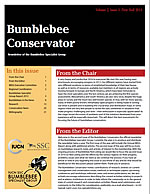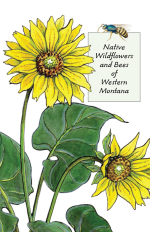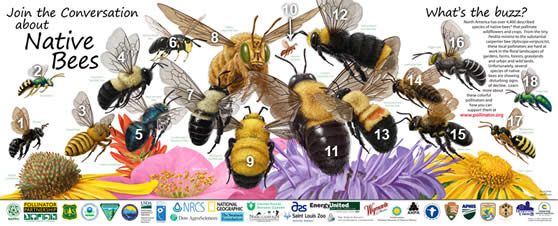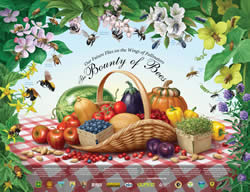Bee Pollination
Bees are the champion pollinators!
In the United States, there are over 4,000 species of native bees. Familiar bees visiting garden flowers are the colorful, fuzzy, yellow-and-black striped bumblebees, metallic-green sweat bees, squash bees, and imported honeybee. These flower-seeking pollen magnets purposefully visit flowers to collect pollen and nectar for food for themselves and their young.
Energy Needs
All bees have very high-energy needs that must be met for their survival. Bees need key resources such as pollen and nectar from a variety of flowers. Bees need these resources for themselves and their progeny. Many bees need water in addition to nectar.
Nesting Habitat
Bee nesting habits vary greatly. For example:
- Mason bees construct nests from mud.
- Leafcutter bees use a "wrapper" of leaves, resin and sand.
- Carder bees harvest plant fibers.
Most bees excavate their nest tunnels in sunny patches of bare ground, while others seek out abandoned beetle burrows in dead tree trunks or branches. The majority of bees are solitary, but a few, like sweat bees, bumblebees, and honeybees, are social, living in colonies that consist of a queen, her worker bee daughters and a few males, the drones.
Bee Flowers
The flowers that are visited by bees are typically:
- Full of nectar
- Brightly colored with petals that are usually blue or yellow or a mixture of these (bees cannot see red)
- Sweetly aromatic or have a minty fragrance
- Open in daytime
- Provide landing platforms
- Often bilaterally symmetrical (one side of the flower is a mirror image of the other)
- Flowers are often tubular with nectar at base of tube
An example of a bee-pollinated flower is a snapdragon or Penstemon (pictured right). Snapdragon flowers have sturdy, irregular shaped flowers with landing platform. Only bees of the right size and weight can trigger the flower to open. Other bee species or other insects that are too small or too large are excluded.
Nectar Guides
Many of the flowers pollinated by bees have a region of low ultraviolet reflectance near the center of each petal. This region appears invisible to humans because our visual spectrum does not extend into the ultraviolet. However, bees can detect ultraviolet light. The contrasting ultraviolet pattern called a nectar guide. This guide helps a bee quickly locate the flower's center.
This adaptation benefits both the flower and the bee. The bee can more rapidly collect nectar and the flower is more effectively pollinated.
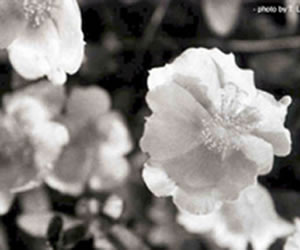 As humans view it!
As humans view it!
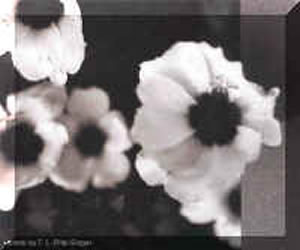 As bees view it!
As bees view it!
Photos courtesy of Apalachicola National Forest.
For More Information
For more information about bees, building bee habitat, or bee gardens visit the following links:
- Insect Basics
- What's the Buzz on Planting a Bee Garden? (PDF, 239 KB)
- Building Native Bee Nesting Blocks: Home-Made Sweet Homes
- Build a Nesting Block
- Urban Bee Gardens, A Practical Guide to Introducing the World's Most Prolific Pollinator into Your Garden
- Honeybee Conservancy - Plant a Bee Garden
By planting a bee garden, you can do your part to help the bees by adding to the shrinking inventory of flower-rich habitat in your area. In return, the bees will pollinate your flowers, providing a bountiful harvest of fruits, seeds and vegetables as well as the joy of watching them up close. - Bee Basics, An Introduction to Our Native Bees (PDF, 1.5 MB), by Beatriz Moisset, Ph.D. and Stephen Buchmann, Ph.D. A USDA Forest Service and Pollinator Partnership Publication.
- Bumble Bees of the Eastern United States (PDF, 5.9 MB), by Sheila Colla, Leif Richardson, and Paul Williams. A product of the USDA Forest Service and the Pollinator Partnership with funding from the National Fish and Wildlife Foundation.
- Bumble Bees of the Western United States (PDF, 7.7 MB), by Jonathan Koch, James Strange, and Paul Williams. A product of the USDA Forest Service and the Pollinator Partnership with funding from the National Fish and Wildlife Foundation.
- Bumblebee Specialist Group - The initial priorities of the Bumblebee Specialist Group are to implement a comprehensive and detailed assessment of the global status of all bumblebee species, based on the International Union for Conservation of Nature (IUCN) Red List criteria, as well as to promote bumblebee conservation worldwide.
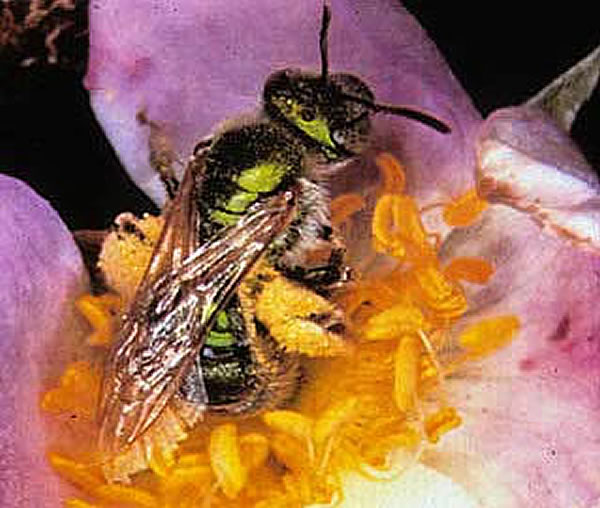 A metallic green sweat bee (Agapostemon) struts her pollen-collecting chops as she visits a wild rose flower on the Wyoming prairie. Photo by LuRay Parker, Wyoming Wildlife.
A metallic green sweat bee (Agapostemon) struts her pollen-collecting chops as she visits a wild rose flower on the Wyoming prairie. Photo by LuRay Parker, Wyoming Wildlife.
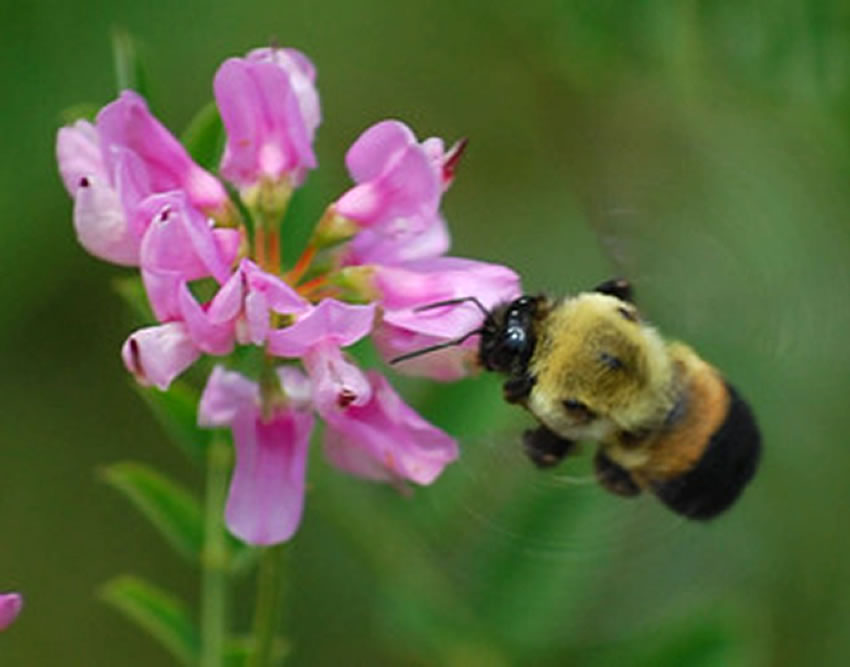 Rusty-patched bumblebee pollinating a blossom. (Photo from discoverlife.org © Copyright Sheryl Pollock 2011.)
Rusty-patched bumblebee pollinating a blossom. (Photo from discoverlife.org © Copyright Sheryl Pollock 2011.)
 A male carpenter bee stealing nectar from the base of a penstemon. Photo by Julian Cowles.
A male carpenter bee stealing nectar from the base of a penstemon. Photo by Julian Cowles.
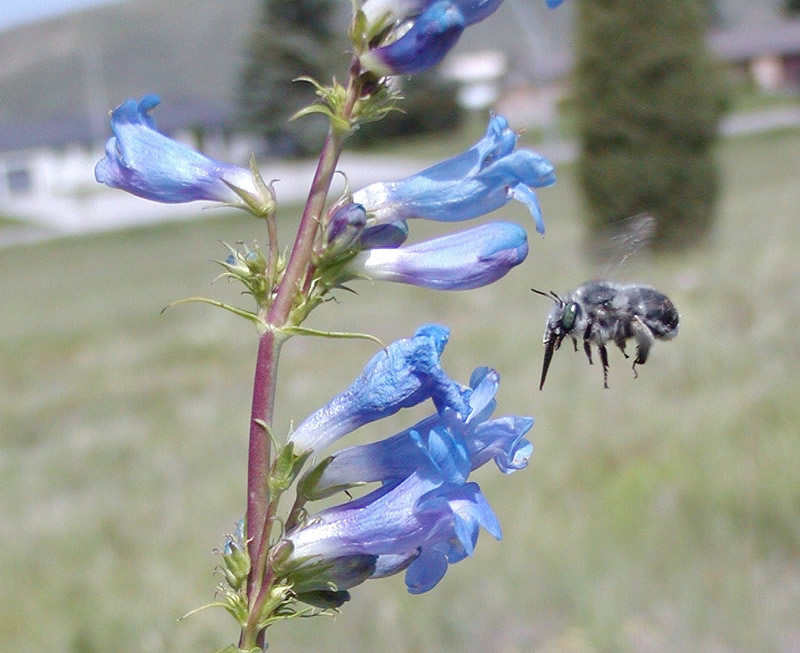 Bee and snapdragon. Photo by Grant Lau.
Bee and snapdragon. Photo by Grant Lau.
Bee Mimics
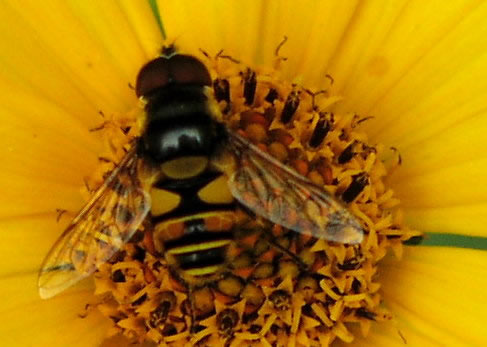 The syrphid fly is a bee mimic. Photo by Beatriz Moisset 2002-2004.
The syrphid fly is a bee mimic. Photo by Beatriz Moisset 2002-2004.
Many insects such as flies and wasps mimic true bees. True bees have two sets of wings. Flies have only two wings. Wasps although they look like are only closely related to bees. Next time you see a pollinator in your garden check to see if it is a bee. Check out “Is it or isn't it a bee?”
Gardening and Landscaping Practices for Nesting Native Bees
Urbanization takes its toll on native bees, but many species can persist with a little help from gardeners and landscapers. Like birds, bees have two primary needs in life: Food (for a bee, pollen and nectar) to feed themselves and their offspring, and a suitable place to nest. The Utah State University Extension and Utah Plant Pest Diagnostic Laboratory has published a fact sheet regarding practices property owners may use to favor nesting native bees.
See Gardening and Landscaping Practices for Nesting Native Bees (PDF)…
Also, see Gardening for Native Bees in Utah and Beyond (PDF)…
Bumblebee Conservator - Volume 2, Issue 1: First Half 2014
Welcome to the second issue of the Bumblebee Conservator, the official newsletter of the Bumblebee Specialist Group. Currently, the plan is to produce and distribute the newsletter twice a year. This first issue of the year will include the Annual BBSG Report along with additional articles.
See the newsletter (PDF, 2.9 MB)…
Native Wildflowers and Bees of Western Montana
Many of us enjoy the beauty of wildflowers, but we may not know their names or how to identify them. This basic guide will help you identify sixteen pairs of common native wildflowers and bees of western Montana that provide vital pollination services. In this this guide, a bee is paired with a flower it is most likely to visit, but it may visit other flower types as well. From early spring through the fall, look for these wildflowers and bees as you walk along forest and grassland trails.
This brochure was prepared and published by the U.S. Forest Service Lolo National Forest, Missoula, Montana. Text is by Susan Reel, design and native plant illustrations by Nancy Seiler, and bee illustrations by Steve Buchanan.
Native Wildflowers and Bees of Western Montana (PDF, 3.8 MB)
Conservation and Management of North American Bumble Bees
 Bombus vagains. Photo by Sheila Colla.
Bombus vagains. Photo by Sheila Colla.
This is a report of the USDA Forest Service and NatureServe with funding from the National Fish and Wildlife Foundation. This document provides a brief overview of the diversity, natural history, conservation status, and management of North American bumble bees, genus Bombus.
Schweitzer, D.F., N.A. Capuano, B.E. Young, and S.R. Colla. 2012. Conservation and management of North American bumble bees. NatureServe, Arlington, Virginia, and USDA Forest Service, Washington, D.C.
Read the report (PDF, 2.8 MB)…
The Pollinator Partnership
Join the Conversation about Native Bees
North America has over 4.400 described species of native bees that pollinate wildflowers and crops. Explore and learn about the pollinators on the Native Bees poster, available from the Pollinator Partnership website…
Bumblebees of the Eastern United States

Twenty-one species of bumble bees (Bombus spp.) occur east of the 100th meridian. This poster made available by the Pollinator Partnership, depicts the bumble bee species occurring east of the Mississippi River in the United States.
Art and Design: Steve Buchanan
Download Print Size Version (PDF, 68.5 MB)
Download Reduced Size Version (PDF, 1.4 MB)
Bumblebees of the Western United States
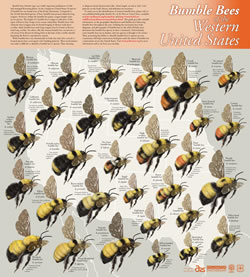
Bumble bees (Bombus spp.) are vitally important pollinators of wild and managed flowering plants. In the contiguous United States 30 species of bumble bee are found west of the Rocky Mountains. This poster made available by the Pollinator Partnership, depicts the bumble bee species occurring west of the Mississippi River in the United States.
Art and Design: Steve Buchanan
Download Print Size Version (PDF, 16.1 MB)
Download Reduced Size Version (PDF, 4.4 MB)
The Bounty of Bees
"Our Future Flies on the Wings of Pollinators"
This poster features important bee species and the important plants they help pollinate, made available by the Pollinator Partnership; USDA Natural Resources Conservation Service, CSREES, and U.S. Forest Service; North American Pollinator Protection Campaign; USDI Bureau of Land Management, U.S. Fish and Wildlife Service, National Park Service, and USGS; Plant Conservation Alliance; Wildlife Habitat Council; Burt's Bees; The National Gardening Association; and, the United States Botanic Garden.
Artist: Steve Buchanan



